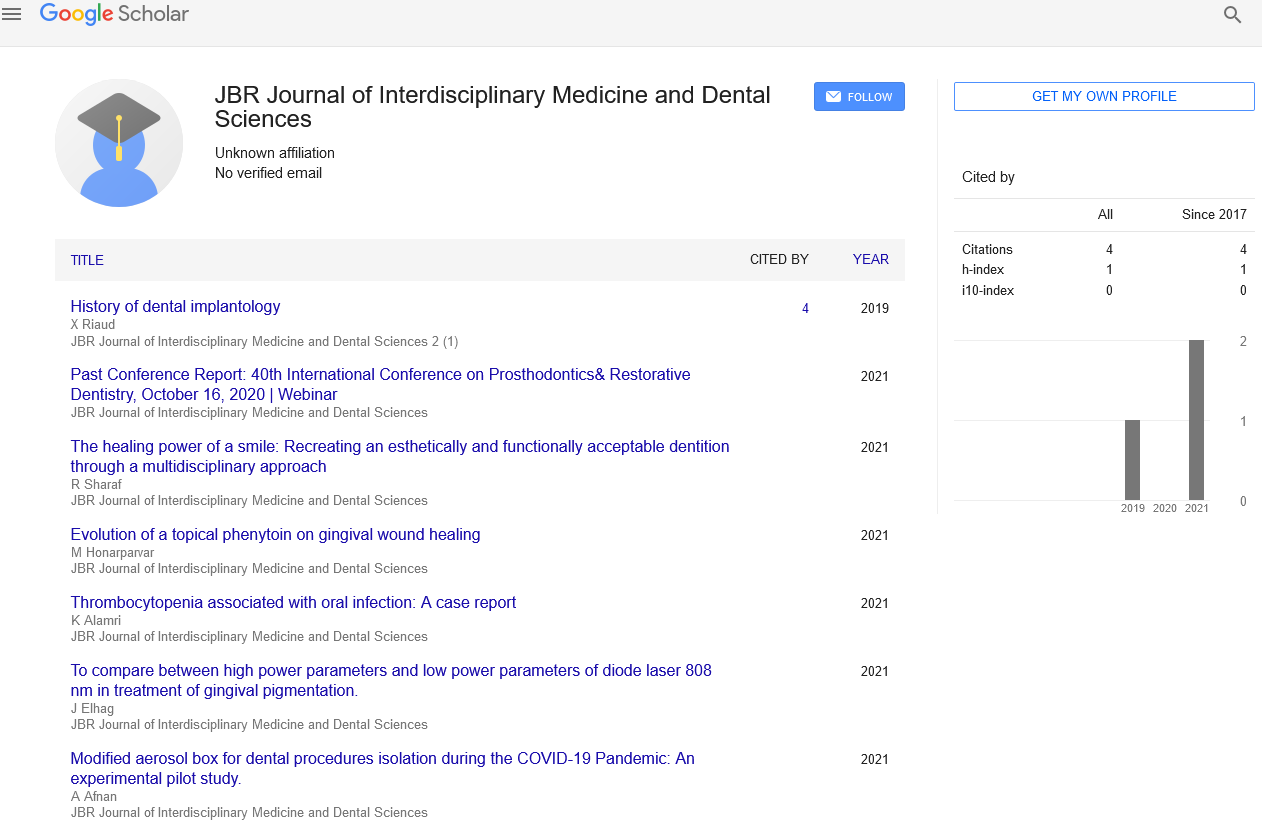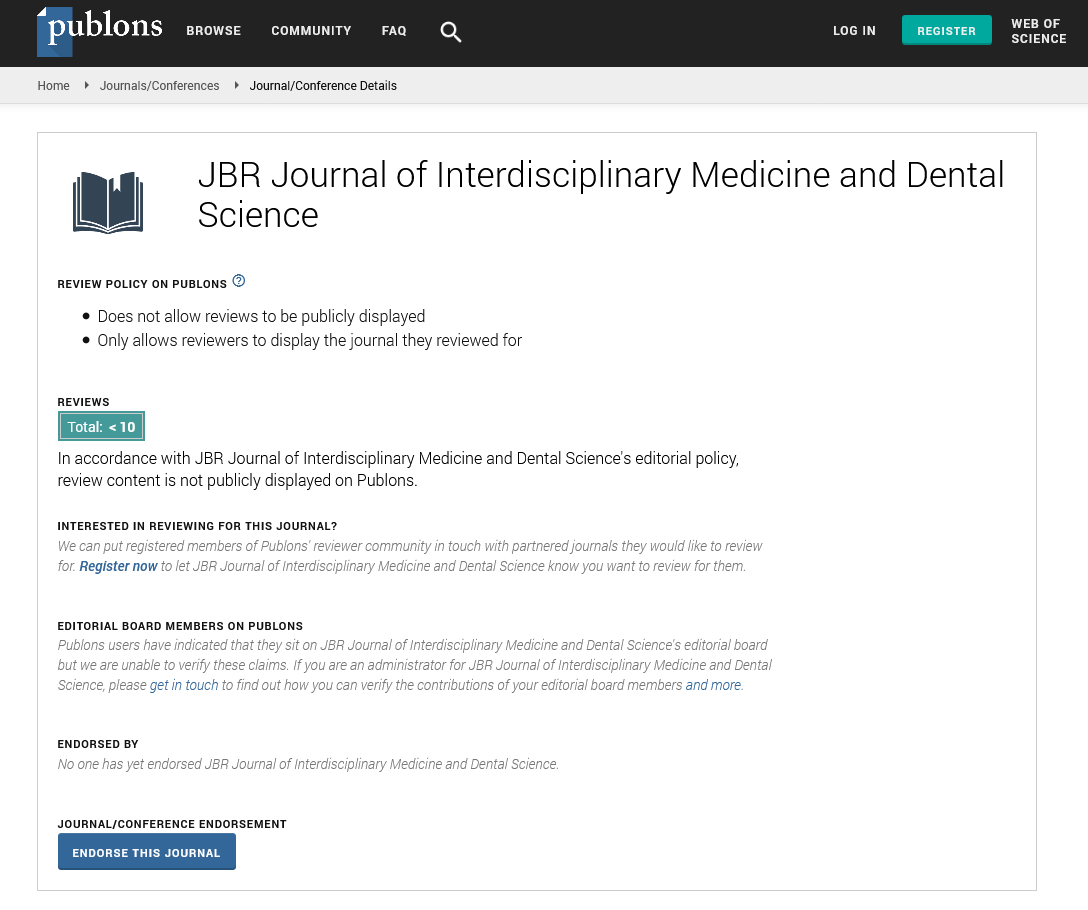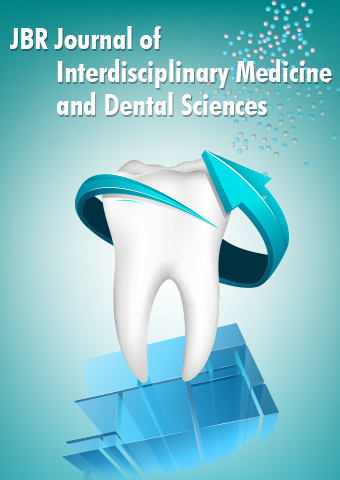Mini Review - JBR Journal of Interdisciplinary Medicine and Dental Sciences (2023) Volume 6, Issue 1
Fracture stress of temporary fixed partial dentures using thermo cycling and long-span fibre reinforced acrylic resin
Suzuka Wang*
Department of Dentistry, Taiwan
Department of Dentistry, Taiwan
E-mail: wangsuzuka@9898.tw
Received: 02-Jan-2023, Manuscript No. JIMDS-23-85862; Editor assigned: 04-Jan-2023, PreQC No. JIMDS-23-85862(PQ); Reviewed: 18- Jan-2023, QC No. JIMDS-23-85862; Revised: 23-Jan-2023, Manuscript No. JIMDS-23-85862(R); Published: 30-Jan-2023, DOI: 10.37532/2376- 032X.2023.6(1).01-03
Abstract
This study examined the fracture stress and fracture pattern of provisional fixed partial dentures (FPDs) reinforced with fibres of various kinds and lengths after thermocycling long-span acrylic resin FPDs.
Introduction
Self-curing acrylic resins have been extensively used in clinical settings for provisionally attached partial dentures in recent years (FPDs). Polymethyl methacrylate (PMMA) restorations are widely used because of their affordability, simplicity of use, and capacity to recreate the contour of defects. PMMA further benefits from greater aesthetic colour and ease of relining and maintenance. Temporary FPD failure or partial breaking is caused by the poor strength of self-curing acrylic resins. Traditional temporary FPDs made of PMMA resin frequently breaks because of severe occlusal stress. Due to the necessity to repair or replace the FPDs, which is significantly more challenging for the dentist, this causes clinical inconvenience. Both dental practitioners and patients often experience discomfort, time loss, and embarrassment as a result of the frequent mechanical failures of temporary fixed prostheses. Enhancing the volume of reconstruction in the FPD and fortifying the acrylic resin with a metal plate have both been introduced in an effort to mitigate the shortcomings of acrylic FPDs and avoid failure in clinical settings. However, the final outcomes either went outside the physiologic boundaries of provisional FPDs or were excessively difficult clinical techniques. The limited area that is available can be reduced by embedding a solid metal framework, which will increase the FPD’s vertical thickness, particularly in the pontics [1]. In certain investigations, fibre application was tried to fortify temporary dental resins. Fiber reinforcement is preferable than metals in terms of mechanical, aesthetic, and cohesive qualities. It also has the benefit of being a lighter composite material. Earlier research on fibre reinforcing frequently focused on strengthening detachable overdentures [2].
Strengthening PMMA resin with fibre-enhanced temporary dental resins. Samples demonstrated significantly higher failure strengths after fibre strengthening, which was performed by embedding fibres at a depth of one-third on the tension side of the test bar.
Early fibres had their surfaces plasma-treated or sandblasted in an effort to improve their adhesiveness. Additionally, the possibility of using glass fibres to fortify temporary dental resins has been explored. The reinforcing site and fibre amount both have an impact on the provisional FPD strength. When building FPDs, Vallittu strengthened PMMA powders and n-butyl methacrylate liquids using various woven forms of glass fibres. The findings revealed that, despite being embedded in disadvantageous places, glass fibre reinforcements significantly enhanced the fracture resistance of provisional FPDs. Similarly, Fatma and Marwa came to the conclusion that glass fibres can strengthen overdentures’ ability to fracture. Despite this, polyethylene fibres have failed to demonstrate effective surface adhesion with resins, even after surface treatment with plasma, radiation, or chemicals. Examined how the placement of the fibre reinforcement affected the fracture resistance of interim FPDs. The findings indicated that the fracture force was significantly influenced by the length of the span and the number of fibres. Studies conducted in vitro using thermocycling to produce material fatigue revealed that the major factor contributing to fractures of interim FPDs is likely material fatigue [3].
The position of the fibre reinforcement is one of the key elements impacting the strengthening efficiency, as has been decisively shown in all of the research listed above. It is currently not possible to obtain comprehensive information regarding freshly created commercial fibres, including the impacts of various surface treatments, the placement of fibre reinforcement, and the strengthening characteristics of various fibre lengths [4].
With two different types of fibre, the fracture load of long-span fiber-reinforced acrylic resin provisional FPDs was calculated in this study. It also looked at the effects of fibre length and reinforcement placement on fracture load following thermocycling [5].
Discussion
The mean fracture load values of the 4-unit pro-visional FPDs reinforced with polyethylene fibres were less than those of the glass fiber- FibreKor specimens. Statistical analysis, however, only showed a negligible difference between these two groups. According to the findings, the steel wires did not have the same capability for strengthening as either type of fibre. The presilanated surface treatment, which exhibited good fracture-resistant qualities even after thermocycling, was the best reinforcing material in the aforementioned groups [6].
Although the microstructure investigations revealed that glass fibre (FibreKor) specimens had more compact structures than polyethylene fibre (Construct) specimens, the fracture load did not substantially differ across the experimental groups. The woven shapes of the fibre constructions are formed from the matrix and broke up after bending failure; the arrows in the photographs show the interfaces between fibres and resin matrices. It is important to note that although the fracture stresses varied somewhat depending on the fibre type (FibreKor and Construct fibres), the microstructures did not [7]. These occurrences Possibly as a result of the fibres effectively reprogression of a slow fracture on the tension side of the temporary FPDs, as well as where the reinforcing fibre as being more crucial for improvement acrylic FPDs have higher fracture stress resistance than the sort of reinforced fibre that was presilanated treatment. The fiber-reinforced location was ensured to be on the tension side of the provisional FPDs by the development of the drilled slots that coincided with the basal plane of the fiber-reinforced provisional FPDs to increase fracture strength. Nearly 50% more fracture stresses were experienced in the 4-mm fiber-reinforced experimental groups than in the control and comparison groups. The mean fracture stresses of the fiber-reinforced groups were higher for the 18-mm and 30-mm lengths than for the 4-mm groups. The statistical study, however, demonstrates that lengthening the fibre reinforcements did not noticeably improve the strength [8]. The strength of connections between pontics is increased, according to our hypothesis, when reinforcement of long-span temporary FPDs with various fibre lengths is extended to both sides of the abutments as well as to the occlusal surfaces of both abutments. The significantly higher fracture loads brought on by fibre addition imply that the strengthened location is far more significant than the length of the reinforcement and that fiber-reinforced dentures should be able to withstand greater tension on the concentration side in order to produce an effective strengthening effect [9]. According to our findings, once the weaker location was reinforced with fibres, the experimental samples, regardless of length, displayed a fracture strength that was 50% greater than the control group. Here, it was demonstrated that embedding polyethylene and glass fibre specimens of varying reinforced lengths on the tension side of the long-span provisional FPDs increased the fracture load to more than 600 N after thermocycling. The typical masticatory force in the human molar region is 500–600 N, hence this result is significant. From the perspective of a therapeutic application, the choice should be made primarily based on the type of fiber-reinforcement surface treatment technique employed; operational convenience and cost factors should also be taken into account. Although alternative fibre lengths were used to reinforce the provisional FPDs, differences in fracture resistance were not statistically significant. This demonstrates how crucial it is to strengthen the weakest area of acrylic resin long-span temporary FPDs. The impacts of periodontal ligaments and proprioceptors, as well as complex occlusal contact patterns in the mouth, were not examined due to the constraints of this study. Therefore, more research based on well-controlled, randomised clinical trials is required [10].
Commercial fibres made of polyethylene and glass, Construct and FibreKor, have shown outstanding adhesion properties to acrylic dental resin. These fibres’ long-span temporary FPDs had a 50% higher fracture stress than those reinforced with steel wire or no reinforcement at all. The tension side between the pontics was where long-span provisional FPDs were weakest in terms of fracture load. In long-span acrylic resin provisional FPDs after thermocycling, the location of fibre strengthening was much more important for fracture stresses than the length of reinforcement or fibre type.
References
- Pfeiffer, Peter, Lars Grube. In vitro resistance of reinforced interim fixed partial dentures.The Journal of prosthetic dentistr.89, 170-174 (2003).
- Nohrström, Tuure J, Pekka K et al. The effect of placement and quantity of glass fibers on the fracture resistance of interim fixed partial dentures.International Journal of Prosthodontics.13 (2000).
- Sadeghi M. Fracture strength and bending of fiber-reinforced composites and metal frameworks in fixed partial dentures.Frontiers in Dentistry. pp, 99-104 (2008).
- Rabie ZH. Effect of Fiber Reinforcement on Fracture Resistance and Fracture Toughness for Long Span Provisional Restorations.Egyptian Dental Journal. 2491-2502 (2019).
- Yao J, Li J, Wang Y et al. Comparison of the flexural strength and marginal accuracy of traditional and CAD/CAM interim materials before and after thermal cycling.The Journal of prosthetic dentistry.112, 649-657 (2014).
- Almeida CS, Amaral M, Gonçalves FCP et al. Effect of an experimental silica-nylon reinforcement on the fracture load and flexural strength of bisacrylic interim partial fixed dental prostheses.The Journal of Prosthetic Dentistry115, 301-305 (2016).
- Balkenhol M, Meyer M, Michel K et al. Effect of surface condition and storage time on the repairability of temporary crown and fixed partial denture materials. Journal of dentistry36, 861-872 (2008).
- Alt V, Hannig M, Wöstmann B et al.Fracture strength of temporary fixed partial dentures, CAD/CAM versus directly fabricated restorations. Dental material. 27, 339-347 (2011).
- Kasthuri S.Effect of S-Glass Fibres on the Flexural Strength of Acrylic Resins used for Temporary Restorations, An In Vitro Study. Diss. KSR Institute of Dental Science and Research, Tiruchengode. (2019).
- Campaner LM, Silveira MPM, Andrade GS et al. Influence of polymeric restorative materials on the stress distribution in posterior fixed partial dentures, 3D finite element analysis.Polymers.13, 758 (2021).
Indexed at, Google Scholar, Crossref
Indexed at, Google Scholar, Crossref
Indexed at, Google Scholar, Crossref
Indexed at, Google Scholar, Crossref
Indexed at, Google Scholar, Crossref
Indexed at, Google Scholar, Crossref


